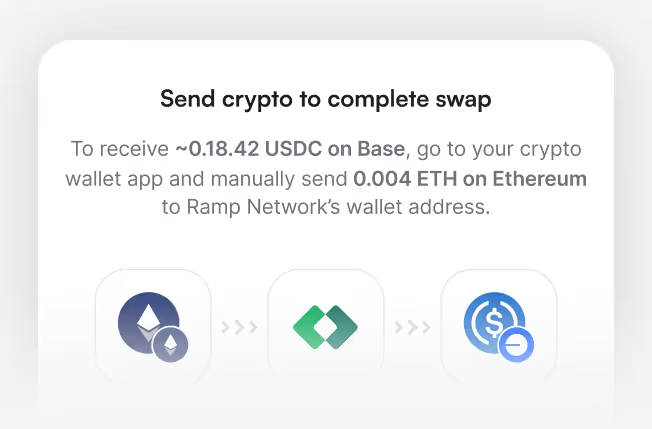


Swap ETH to USDT instantly.
Exchange Ethereum (ETH) for Tether (USDT) quickly and securely with Ramp Network. Clear, step-by-step flow – no bridges, no DEXs, no hidden steps.


.svg)










Exchange Ethereum (ETH) for Tether (USDT) quickly and securely with Ramp Network. Clear, step-by-step flow – no bridges, no DEXs, no hidden steps.


.svg)







Swapping Ethereum (ETH) for Tether (USDT) with Ramp Network is quick, secure, and straightforward.

1
Choose Ethereum (ETH) and Tether (USDT), enter the amount you’d like to swap, and review the live conversion rate before continuing.

2
Sign up with your preferred method and confirm your country of residence to move forward.

3
Ramp Network supports both self-custodial wallets such as MetaMask or Ledger and custodial exchange accounts. You stay in full control of your funds at every step.

4
Transfer ETH from your wallet. Once the transaction is confirmed on the network, the equivalent amount of USDT is delivered directly to your chosen wallet or exchange account.

Ramp Network supports both self-custodial wallets like MetaMask or Ledger and custodial exchange accounts. When swapping ETH for USDT, simply connect your wallet, review the details, and confirm the transaction.






The swap flow is built to stay intuitive and straightforward. Ramp Network avoids complex blockchain terminology, making ETH-to-USDT swaps easy even for first-time users.
You remain in full control of your funds. ETH is sent directly from your wallet, and USDT is delivered to the wallet or exchange account you specify. Ramp Network never holds user assets beyond what’s required for settlement.
Ramp Network operates in major regions including the UK, EU, and US. Supported networks and assets are displayed clearly during checkout.

Before completing your ETH-to-USDT swap, you’ll see a complete overview of the transaction, including live exchange rates and applicable fees, so you always know what to expect.
*When compared to transferring via an exchange

Ethereum appeared in 2015 and quietly changed everything. Unlike Bitcoin, which was built just to move money, Ethereum could run code. It allowed anyone to create small, self-operating programs called smart contracts. That single idea kicked off the world of decentralized apps.
ETH is what makes the network work. People use it to pay for transactions, stake it to help keep the network safe, and interact with thousands of apps built on top. From NFTs to DeFi tools, most of today’s Web3 ecosystem still runs on Ethereum.
Over time, Ethereum became faster and cleaner. It moved from energy-intensive mining to a proof-of-stake system that’s better for the environment. It keeps evolving, but its purpose stays simple: to give people a way to build and exchange value without middlemen.
Bitcoin (BTC) is the world’s first cryptocurrency, launched in 2009 by the mysterious creator known as Satoshi Nakamoto. Built on blockchain technology, Bitcoin introduced a new way of transferring value online without the need for banks or intermediaries. Its decentralized nature, combined with a fixed supply of 21 million coins, makes it a unique digital asset often referred to as “digital gold.”
Today, Bitcoin is the most recognized and widely used cryptocurrency worldwide. Millions of people use it for trading, investing, and cross-border payments, while businesses across industries accept Bitcoin payments as a secure and transparent alternative to traditional money. Its popularity continues to grow, supported by increasing adoption from financial institutions, mainstream investors, and even governments exploring Bitcoin regulation.
What makes Bitcoin special is its combination of scarcity, security, and decentralization. Unlike fiat currencies that can be printed endlessly, Bitcoin’s supply is limited, creating long-term value potential. Its blockchain is maintained by thousands of nodes across the globe, ensuring transactions remain transparent and resistant to censorship. For many users, Bitcoin represents more than just an investment — it’s a revolutionary step toward financial freedom and the future of money.
The chart displays an indicative, mid-market exchange rate. Effective exchange rate might be different.

Tether, or USDT, was launched back in 2014 as a digital version of the U.S. dollar. Each token is backed by real-world reserves like cash and short-term treasuries, which helps it stay stable at around one dollar. That makes it useful for everyday payments and for moving funds between crypto exchanges.
People use USDT to send money abroad, trade on exchanges, or store value between market swings. It runs on several blockchains such as Ethereum, Tron, and Solana, which keeps it fast and affordable to use.
Most users don’t think of it as an investment but as a simple tool – a bridge between traditional money and the crypto economy. You can send it in minutes, with low fees, and no banks standing in the way.
Bitcoin (BTC) is the world’s first cryptocurrency, launched in 2009 by the mysterious creator known as Satoshi Nakamoto. Built on blockchain technology, Bitcoin introduced a new way of transferring value online without the need for banks or intermediaries. Its decentralized nature, combined with a fixed supply of 21 million coins, makes it a unique digital asset often referred to as “digital gold.”
Today, Bitcoin is the most recognized and widely used cryptocurrency worldwide. Millions of people use it for trading, investing, and cross-border payments, while businesses across industries accept Bitcoin payments as a secure and transparent alternative to traditional money. Its popularity continues to grow, supported by increasing adoption from financial institutions, mainstream investors, and even governments exploring Bitcoin regulation.
What makes Bitcoin special is its combination of scarcity, security, and decentralization. Unlike fiat currencies that can be printed endlessly, Bitcoin’s supply is limited, creating long-term value potential. Its blockchain is maintained by thousands of nodes across the globe, ensuring transactions remain transparent and resistant to censorship. For many users, Bitcoin represents more than just an investment — it’s a revolutionary step toward financial freedom and the future of money.
The chart displays an indicative, mid-market exchange rate. Effective exchange rate might be different.
Customers like you have traded over $1 billion in crypto with Ramp Network.